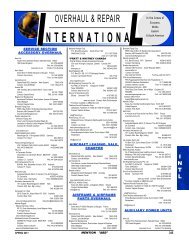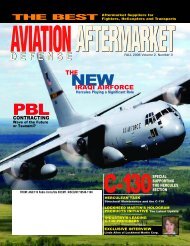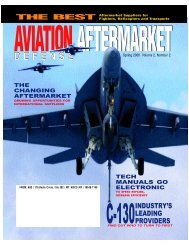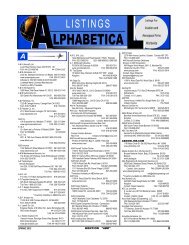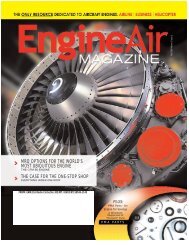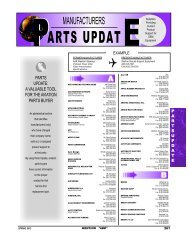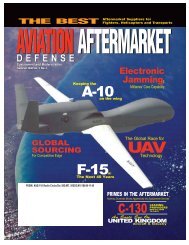You also want an ePaper? Increase the reach of your titles
YUMPU automatically turns print PDFs into web optimized ePapers that Google loves.
program at Beale Air Force Base in California,<br />
explains that the aircraft is largely automated and<br />
occasionally does the unexpected. When that<br />
happens, Northrop Grumman technicians have<br />
been able to go back and determine why the<br />
aircraft did what it did from reviewing the data<br />
logs.<br />
For example, early on in the program, it was<br />
discovered that taxiing a Global Hawk presented<br />
problems. The RQ-4 is designed to turn short of its<br />
programmed waypoints to provide a smooth taxi<br />
line. Taxiing around a curved taxiway is achieved by<br />
plotting a series of points on the intended track.<br />
The first time that technicians attempted to taxi an<br />
RQ-4 around a curve, they found that the result of<br />
the turn-short feature was that the radius on the<br />
curve the aircraft actually followed was substantially<br />
less than the radius on the mission plan. The<br />
solution to this problem was to plot additional<br />
points and use a wider radius circle than the<br />
intended taxi path. That way, when the aircraft<br />
turned short, it was where it was supposed to be.<br />
Long-endurance unmanned aerial vehicle (UAV)<br />
design puts a premium on light weight. RQ-4<br />
aircraft use integrated fuel tanks, as opposed to<br />
fuel bladders, to cut down on weight and increase<br />
fuel capacity.<br />
To further minimize weight, the fuel system on<br />
the first RQ-4s, the Block 10s, is very rudimentary.<br />
These aircraft are refueled using the over-the-wing<br />
method (to refuel, the maintainer must hold a fuel<br />
hose nozzle in an opening on the wing), as<br />
opposed to having a single-point receptacle. This<br />
technique results in uncertainty about the quantity<br />
of fuel loaded, so the aircraft must be weighed<br />
after each refueling to determine if it has received<br />
the full amount of fuel needed for its mission.<br />
In the beginning, maintenance crews used the<br />
same type of scales utilized to weigh cargo pallets<br />
for this task. This approach was problematic,<br />
however, because maintainers had to find and<br />
attach ramps to the scales, and then tow the<br />
aircraft up these ramps to get them onto the<br />
scales. Since then, a variety of lower profile scales<br />
have been used that have smaller ramps built into<br />
them, thus making the process much easier. The<br />
scales currently in use at Beale Air Force Base are<br />
made by the Intercomp Company, of Medina,<br />
Minnesota.<br />
In Block 10 aircraft, fuel inevitably flows to the<br />
lower wing during the refueling process, resulting<br />
in the need to elevate this heavier wing section<br />
with a jack to ensure that fuel gets out to the<br />
farthest fuel tanks in both wings. Newer Block 20<br />
RQ-4s have been equipped with single-point<br />
refueling capabilities, a feature that was strongly<br />
advocated for by maintenance personnel, mainly<br />
for ease of refueling and de-fueling.<br />
In addition to the single-point capability,<br />
Northrop Grumman added capacitance probes to<br />
replace the float switches used in the earlier Block<br />
10s. Unfortunately, it was discovered during testing<br />
that not enough probes were added to give<br />
KEEPING THE RQ-4 IN THE AIR<br />
Airman Todd, refuels<br />
the Global Hawk on<br />
the flightline at Beale<br />
Air Force Base in<br />
California.<br />
WWW.ABDONLINE.COM AVIATION AFTERMARKET <strong>DEFENSE</strong> | SPRING 2010<br />
35<br />
Photo by Airman 1st Class Krista Rose



